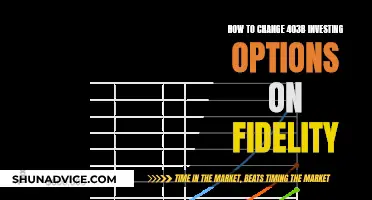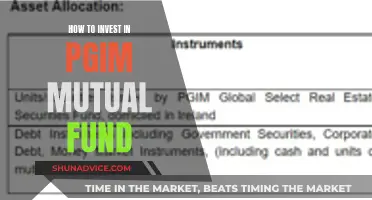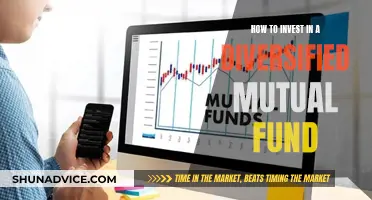
There are thousands of mutual funds to choose from, so it's important to do your research and understand your goals and risk tolerance before investing. Here are some key things to consider when picking a fund to invest in:
- Investment goals and risk tolerance: Are you looking for long-term capital gains or current income? Do you want steady growth with low risk or higher potential returns? Are you willing to tolerate large swings in your portfolio's value? Knowing your investment goals and risk tolerance will help you narrow down the types of funds that are suitable for you.
- Management style: Mutual funds can be actively or passively managed. Actively managed funds have portfolio managers who actively select securities and assets to include in the fund, while passively managed funds, or index funds, seek to track and duplicate the performance of a benchmark index. Actively managed funds tend to have higher fees and may not always outperform the market, so it's important to consider the trade-offs.
- Fund type: Different types of funds specialize in different segments of the market, such as large-cap funds (investing in large, well-established companies), small-cap funds (investing in smaller, potentially higher-growth companies), value funds (investing in undervalued companies), growth funds (investing in rapidly growing companies), and income funds (paying regular dividends or interest).
- Fees: Mutual funds typically charge various fees, such as load fees (charged when buying or selling shares) and expense ratios (an annual percentage of assets used to cover fund expenses). It's important to understand the different types of fees and how they can impact your investment returns.
- Performance: While past performance doesn't guarantee future results, it's still important to evaluate a fund's track record. Look at how the fund has performed compared to the market and consider factors such as volatility and turnover.
- Diversification: Diversifying your portfolio across different types of funds, sectors, and asset classes can help reduce risk and improve long-term performance.
| Characteristics | Values |
|---|---|
| Management Style | Active or Passive |
| Investment Goals | Long-term capital gains or current income |
| Risk Tolerance | High or Low |
| Time Horizon | Long or Short |
| Fund Type | Large-cap, Small-cap, Value, Growth, Income, etc. |
| Fees | Load fees, expense ratio, 12b-1 fees, etc. |
| Performance | Historical performance, volatility, turnover |
| Diversification | Diversified portfolio or specialised fund |
What You'll Learn

Active vs. passive management
When deciding how to invest, one of the first choices you'll need to make is whether to take an active or passive approach. Here's what you need to know about the two strategies.
Active Management
Active management is a hands-on approach where a portfolio manager or other active participant buys and sells investments based on their performance or potential. Active managers aim to beat the market by achieving better returns than a standard benchmark, such as the S&P 500 or Russell 3000. Active management requires in-depth analysis and expertise to know when to pivot into or out of a particular stock, bond, or asset.
Advantages of Active Management
- Flexibility: Active managers can buy any investment that meets their criteria and are not restricted to following a specific index.
- Hedging: Active managers can use strategies like short sales and put options to hedge their bets and reduce risk.
- Risk management: Active managers can exit specific holdings or sectors when risks become too large.
- Tax management: Active managers can tailor tax strategies to individual investors, such as selling investments that are losing money to offset taxes on winners.
Disadvantages of Active Management
- Expensive: Actively managed funds have higher fees to cover the cost of research, analysis, and portfolio management. These fees can eat into returns over time.
- Active risk: Active managers have the freedom to buy any investment that meets their criteria, which can introduce risk.
- Management risk: Fund managers are human and can make costly mistakes.
Passive Management
Passive management, also known as index investing, involves buying and holding a diverse range of investments with minimal portfolio turnover. Passive investors aim to match the performance of a market index rather than trying to outperform it. Passive managers simply seek to own all the stocks in a given market index, in proportion to that index.
Advantages of Passive Management
- Low fees: Passive funds have ultra-low fees because they don't require stock picking or extensive analysis.
- Transparency: It's always clear which assets are in an index fund.
- Tax efficiency: The buy-and-hold strategy of passive funds doesn't typically trigger a large capital gains tax.
- Better performance: Passive funds tend to outperform active funds over the long term, especially once fees are factored in.
Disadvantages of Passive Management
- Limited: Passive funds are restricted to a specific index or set of investments and cannot deviate from those holdings, regardless of market conditions.
- Small returns: Passive funds rarely beat the market and are unlikely to deliver significant returns.
- Reliance on fund managers: Passive investors rely on fund managers to make investment decisions and don't have a say in specific investments.
Both active and passive management strategies have their advantages and disadvantages. Active management offers more flexibility and risk management options but comes with higher fees. Passive management provides low fees and transparency but may result in smaller returns. Ultimately, the choice between active and passive management depends on your financial goals, risk tolerance, and personal preferences.
Savings Strategy: Mutual Funds Investment Allocation
You may want to see also

Risk tolerance
- Financial Goals: Are you investing for growth, income, or a mix of both? If you are primarily focused on growth, you may be willing to take on more risk. If you seek stable income, you may prefer lower-risk investments.
- Time Horizon: Your investment time horizon is also crucial. If you are investing for the long term, you may be comfortable with higher-risk investments, as you have time to ride out market fluctuations. If you need to access your money in the short term, lower-risk investments are generally more appropriate.
- Personal Comfort: Everyone has a different tolerance for volatility and risk. Some people are comfortable with aggressive investment strategies, while others prefer a more conservative approach. It's essential to be honest with yourself about your comfort level with risk.
- Age: Your age can also be a factor in risk tolerance. Younger investors tend to have a longer investment horizon and may be more comfortable with riskier investments. As you approach retirement age, you may want to shift towards more conservative investments.
- Diversification: Diversification is a risk management technique. By spreading your investments across various assets, sectors, and geographic regions, you can reduce the impact of any single investment loss. A well-diversified portfolio can help you manage risk and protect your portfolio during market downturns.
When considering risk, it's important to remember that higher-risk investments can offer higher potential returns but also carry a greater possibility of loss. Lower-risk investments, on the other hand, may provide more stable returns but typically have lower upside potential.
Additionally, it's worth noting that risk tolerance can change over time as your financial situation, goals, and market conditions evolve. Regularly reviewing and adjusting your investment strategy to align with your risk tolerance is essential for effective long-term investing.
Mutual Fund Investment Strategies: Where to Invest?
You may want to see also

Fund performance
When considering a mutual fund's performance, it's important to remember that past performance does not guarantee future results. However, there are still several factors to consider when evaluating a fund's performance.
Firstly, it's crucial to assess the fund's performance in relation to its benchmark index. Did the fund deliver results consistent with general market returns? Was it more volatile than the major indexes? Evaluating these factors will provide insight into how the fund performs under certain conditions.
Secondly, consider the fund's turnover rate. A high turnover ratio indicates a lack of confidence by the management team in their investment choices or an attempt to time the market for bigger returns. High turnover can also result in higher tax costs for investors in brokerage accounts.
Thirdly, examine the fund's long-term performance. While very few top-performing funds remain near the top for long, funds with a long track record of strong performance may be a better choice. Additionally, consider funds with consistent performance over time, as this indicates the fund's ability to navigate different market conditions.
Finally, it's essential to look beyond recent returns and consider factors that will influence future results. Morningstar, a leading investment research firm, takes into account a fund's investment strategy, the longevity of its managers, expense ratios, and other factors in their ratings.
Remember, while performance is important, it's not the only factor to consider when choosing a mutual fund. It's crucial to evaluate your investment goals, risk tolerance, fund management style, fees, and diversification as well.
Smart Mutual Fund Investments: 16K Options
You may want to see also

Management experience
- Track Record and Performance: Look for fund managers with a proven history of strong returns or ROI. Evaluate their long-term performance, preferably over a period of 10 years or more. Avoid managers who frequently change their investment strategies or underperform the market.
- Tenure and Consistency: Experienced fund managers with at least 5–10 years of industry experience are generally preferred. Consistency in management is also important. A fund with a stable and consistent management team is more likely to deliver reliable performance.
- Investment Strategy: Understand the fund's investment strategy and how the manager plans to achieve its goals. Evaluate if the strategy aligns with your own investment objectives and risk tolerance.
- Market Research and Monitoring: A good fund manager should have a thorough understanding of the market and perform in-depth research to back their investment decisions. They should also actively monitor the fund's performance and make adjustments as needed.
- Ratings and Recognition: While not the sole deciding factor, consider ratings and recognition given to fund managers by reputable organizations. These ratings often evaluate the manager's performance, investment strategy, and risk-adjusted returns.
- Risk Management: Assess how the fund manager handles risk. Look for managers who have a well-diversified portfolio across different sectors and industries, minimizing the impact of any single market downturn.
- Turnover Ratio: A high turnover ratio indicates frequent buying and selling of investments, which may suggest higher trading costs and a short-term investment approach. A low turnover ratio indicates a more long-term investment strategy.
- Costs and Fees: Consider the costs associated with the fund management. High fees can eat into your investment returns over time. Compare the expense ratios and transaction fees of different funds to make an informed decision.
Remember, management experience is just one aspect of evaluating a mutual fund. It should be considered alongside other factors such as the fund's investment strategy, performance, costs, and your own investment goals and risk tolerance. Conduct thorough research and seek professional advice when needed to make a well-informed investment decision.
ETFs and Mutual Funds: Key Investment Considerations
You may want to see also

Fund fees
- Load Fees: Some funds charge a sales fee called a load fee, which can be front-end or back-end. A front-end load fee is paid when you buy shares in the fund, while a back-end load fee is charged when you sell your shares, typically before a set time period such as five to ten years from the purchase date. These fees can range from 3% to 6% of the total amount invested or distributed, but can go as high as 8.5% by law. They are intended to deter investors from frequently buying and selling and to cover administrative charges.
- Expense Ratio: The expense ratio represents the total percentage of fund assets charged to cover fund expenses. It includes management fees, distribution fees (12b-1 fees), and other expenses. A higher expense ratio means lower returns for investors. According to a recent report, the average expense ratio for actively managed funds was 0.68% in 2021. In comparison, the average for index funds was 0.06%.
- Transaction Fees: Some funds may also have transaction fees, sometimes called loads. These fees reduce your initial investment in the fund and can impact your returns over time. However, funds without transaction fees may charge higher ongoing fees, so it's important to compare the total costs.
- Management Fees: Actively managed funds often have higher fees because they involve portfolio managers who actively research and make investment decisions. The average expense ratio for an actively managed equity fund was 0.66% in 2022. On the other hand, passively managed funds or index funds have lower fees, with an average expense ratio of 0.05% in 2022.
- No-Load Funds: While some funds don't charge load fees, they may have higher management expense ratios or other charges. It's important to carefully review the fee structure of no-load funds to ensure there are no hidden costs.
- 12b-1 Fees: These fees are included in the share price and are used for fund distribution, promotions, and sales. They can be as high as 1% of your investment in the fund, and investors may not always be aware of them.
When evaluating fund fees, it's essential to consider your investment goals, risk tolerance, and time horizon. Additionally, remember that fees can eat into your returns, so it's crucial to factor them into your decision-making process when selecting a mutual fund.
Vanguard Windsor II: Uncovering its Security Strategy
You may want to see also
Frequently asked questions
There are thousands of mutual funds in the market, and they can be categorised into a few types that specialise in different segments of the market. Here are some examples:
- Large-cap funds: These funds invest in large, widely held companies with market capitalisations usually worth $10 billion or more.
- Small-cap funds: These funds tend to invest in companies with market capitalisations between $300 million and $2 billion.
- Value funds: Value funds consist of stocks that are perceived to be undervalued. These are typically well-established companies trading at a discount.
- Growth funds: Growth funds invest in companies that are rapidly growing, with a focus on capital appreciation. They may have a high price-to-earnings ratio.
- Income funds: Some funds pay regular income in the form of dividends or interest, such as dividend stocks and bond funds.
While past performance does not guarantee future results, it can give you an indication of how a fund might perform in the future. Look at the fund's historical performance and compare it to its benchmark. You can also look at the fund's volatility to understand the level of risk. Additionally, consider the fund's risk-adjusted performance over 3-, 5-, and 10-year periods.
Fees can significantly impact your investment returns, so it's important to be mindful of them. Some common fees include front-end load fees, back-end load fees, and expense ratios. Front-end load fees are charged when you buy shares, while back-end load fees are charged when you sell your shares. The expense ratio is the percentage of assets paid to run the fund, and it includes management fees, distribution fees, and other expenses.







